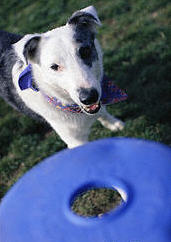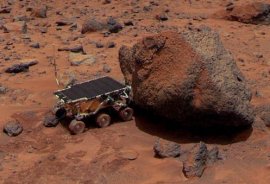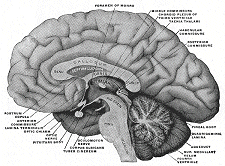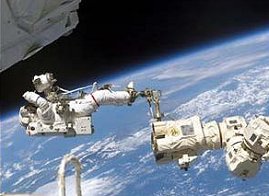|
Exploring our solar system will require a
new breed of intelligent robots.
by Patrick L. Barry and Dr
Tony Phillips
Yelling "Fetch, Rover!"
the man tosses a frisbee far across the yard. His dog just stands
there and does nothing.
Oh yeah, he thinks, I forgot. "Rover! Turn clockwise
until you face north-by-northwest, move forward ten-point-five meters
and stop, lower your head fourteen centimetres, then close your
mouth on the frisbee," he instructs. "After that ... return!"
The dog bounds across
the yard, only to return with nothing in his mouth. The frisbee
had been 2 cm farther forward than the man said - but the dog couldn't
make that small adjustment on its own. So the man gives his long-winded
instructions again, substituting "ten-point-five-two" this
time.
Playing fetch this
way is no fun at all.
But it could be worse.
What if you were an astronaut newly-landed on the surface of Mars
and Rover was your robotic assistant? With only a few precious months
to explore Mars, Rover would be a tremendous waste of your time.
Having no common sense or flexibility, Rover could even be a danger
to you in the unforgiving environment of a distant planet. It might
blindly follow instructions that cause it to damage vital equipment,
and it would ignore the plain-language pleas of an astronaut in
distress.

Image credit and copyright: Lawrence Manning
Rover plays
fetch with a frisbee
|
The Sojourner rover
that explored Mars' surface in 1997 operated much like our clueless
canine. Teams of scientists here on Earth had to feed Sojourner
precise, step-by-step instructions for each task it performed. If
the rover hit a snag, it would just stop and wait. The scientists
then had to tell it exactly how to overcome the problem. It took
days just to get simple tasks done.
Sojourner was nevertheless successful thanks to the ingenuity and
patience of its controllers. Yet much more was possible. If we're
serious about exploring the solar system, say mission planners,
we must build smarter and more capable robots.
"During the next decade,"
says NASA Ames roboticist Liam Pedersen, "there's not likely to
be a human presence much beyond Earth orbit. So if we wish to explore
places like Mars, we'll have to send robots. No robots, no exploration.
Period."
"Transmitting detailed
instructions to essentially dumb robots is grossly inefficient and
expensive - especially when there's lots to do," he adds. For example:
Robots scouting Mars, perhaps in advance of human explorers, will
reconnoitre vast areas. They'll sample hundreds of rocks, drill
holes in search of frozen water, and take thousands of pictures.
"If each of these operations takes several days and a standing army
of mission controllers ... well, you can see how the cost increases."

more
In 1997,
the Sojourner rover "sniffs" a Martian rock named Yogi.
|
The first humans on
Mars will be just as busy as the scouts that precede them. Astronauts
will have to set up the first base camp on an alien world and learn
to survive in a place that makes Antarctica seem mild. And while
they're at it, they'll collect thousands of measurements for scientists
back on Earth.
"An astronaut's time
will be more precious than edible gold," says Pedersen."They're
going to need smart robot helpers."
How smart? The kind
of intelligence that we usually take for granted in animals would
do fine, says Pedersen. Animals effortlessly distinguish the objects
in their environment based on the input of their senses. They can
recognize threats, and they intuitively understand how objects move
and behave. They can identify goals - like a little scurrying morsel
of food - and then plan and perform all the actions needed to get
it. And they know their own limitations of energy, strength, temperature,
and endurance, and they're careful not to exceed these.
Getting a robot to
do all this is not easy.
Pedersen says, "try
teaching this simple lesson to a robot: 'You can't turn a glass
of water upside-down because the water will fall out.' To us, that's
extremely obvious. It's common sense. But if you want a machine
to understand that, you've got to spell it out in painful detail."
The computer brains
of conventional robots operate in basically the same way as home
computers do: They execute a fixed program of "if-then" logic and
computations. The speed and precision of this approach makes computers
extremely good at narrow, specialized tasks. But it also makes them
inflexible. Confront a conventional robot with a situation outside
the scope of its programming, and it's clueless about how to respond.
The adaptability and novel problem-solving ability of humans (and
many animals) has proven very hard to reproduce.
Nevertheless, a patchwork
of approaches to more-flexible computing has emerged. Among these
are technologies like probability theory, evolutionary computing,
natural language recognition and neural networks. Each provides
a way to add learning or flexibility to a robot.
For example, scientists at Carnegie Mellon University taught a robot
to steer a car autonomously for 98% of a drive across the U.S. - a
project cleverly called "No Hands Across America." They first trained
the robot by letting it ride along and watch as a human drove the
car. The robot learned to associate certain visual inputs with the
correct steering responses.

more
A simple
example of a neural network. Input signals enter from
the left, pass through the two processing layers, then
emerge on the right as output signals. This architecture
can perform surprisingly sophisticated logic, especially
when feedback loops are added.
|
The "brain" of this
robot was a computer simulation of a neural network, which mimics
in a rudimentary way the architecture of animal brains. Input signals
are processed by webs of "nodes" (neurons) and "links" (axons).
Neural networks learn from experience and can associate general
inputs with specific outputs: four legs + a bark (the inputs) =
a dog (the output), for instance.
Pedersen cautions that
the inner workings of organic brains are too poorly understood to
mimic precisely. "While neural networks are in some ways similar
to organic brains," he says, "they remain vastly less complex or
capable."
Probability theory,
especially Bayesian statistics, provides another path to machine
learning, says Pedersen. It allows computers to operate not only
in terms of black and white - true or false - but also in shades of
gray. Machines that "think" using such statistical models learn
well from new and unexpected experiences. ("This is where I would
consider the excitement to be in robotics," notes Pedersen. "Watch
out for an explosion in robot capabilities.")

Image credit: Grey's
Anatomy
The human
brain - we all have one, yet its inner workings are mysterious.
Learning more about organic brains might help researchers
program smarter robots.
|
Yet another possibility
is evolutionary computing, in which computers "evolve" their own
software. "Mutants" of an original program are tried, and those
that produce better results are preserved. Their code is then mixed
and mutated again - like sexual reproduction - to produce the next
"generation," and so on for hundreds or thousands of generations.
This software "evolution" can produce very effective problem-solving
programs that are too complex for the scientists themselves to understand.
These and other novel
approaches to computing form the foundation for smarter, more autonomous
robots. Scientists draw from this toolbox to build into robots those
abilities that we take so much for granted in ourselves: understanding
the meaning of spoken language, figuring out all the little actions
needed to complete a task, navigating across terrain and avoiding
dangers - the nitty-gritty of autonomous exploration.
Progress is indeed
being made. One prototype robot called Hyperion has shown the ability
to autonomously traverse the terrain of the Canadian Arctic. Developed
by researchers at Carnegie Mellon's Robotics Institute, this robot
carefully navigates to avoid being caught in shadows, so that its
solar panels are always receiving sunlight. And it's smart enough
to know when it's lost or in trouble.
Another experimental robot, called the
Extra-Vehicular Activity Robotic Assistant (ERA), is a true astronaut
partner - roving on wheels side-by-side with a space-suited human.
Scientists at the Johnson Space Center are using it to test advanced
technologies like natural-language interaction and recognition of
astronauts' gestures. Much of what they learn will help design similar
assistants, not only for planetary surfaces, but also for Earth
orbit and deep space.
Notes Pedersen: "Here
at Ames we're working on a rover called K9 that will be able to
do many things on its own. It can look at rocks, make measurements,
and decide what's 'interesting.' K9 is a technology testbed for
the 2003 Mars Exploration Rovers and for the 2009 Mars Science Laboratory
(a.k.a. the Mars Smart Lander and Mobile Laboratory).
Other experimental robots are pioneering a different frontier: life
onboard a spaceship. The Personal Satellite Assistant (PSA), for
example, is a small floating sphere that can propel itself using
fans through a spaceship's corridors. Created by Yuri Gawdiak and
colleagues at NASA Ames, the PSA looks remarkably like Luke Skywalker's
robotic light-saber sparring partner from Stars Wars. That's
no coincidence, says Gawdiak, who dreamed up the PSA after watching
the movie.

(left)
An artists' concept of Robonaut working outside a spaceship.
(centre) Yuri Gawdiak of NASA Ames and his Personal
Satellite Assistant. (right) The smart rover K9
during field tests at NASA Ames.
|
The PSA will be able
to do many things: talk to astronauts who want information from
the ship's main computer; monitor the air (like a canary in a coal
mine) for concentrations of potentially harmful gases, e.g.,
too much CO2; or simply venture into situations that
might be too dangerous or uncertain for their human crewmates. Such
high-tech helpers would be welcomed on the International Space Station.
Other robots are best-suited
for duty outside the spaceship. Robonaut, for example, is under
development at the Johnson Space Center. It has the basic shape
of a human - or rather a half-human. Its body stops at the waist.
Its arms and hands are designed to be very dexterous, and its head
contains video cameras. Astronauts, safely inside their ship, could
perform routine maintenance or important repairs to the outside
of the ship using Robonaut as a remote-controlled proxy.
If robots are going to live onboard spaceships, notes Pedersen,
then the spaceships must be designed with robots in mind. "The need
for this kind of system-level design - designing the robot and the
spaceship to each suit the other - is often overlooked by non-experts,"
he says. The ship must have facilities for recharging and storing
the robot, and the robot must be able to access the ship's computers
and handle any necessary equipment.
The International Space
Station and its robotic arm, Canadarm2, are an example of a well-integrated
system. The arm crawls on the outside of the station - flipping end
over end like an inchworm from one specially-placed handhold to
the next. A custom-made trolley can quickly transport the arm from
place to place when speed is of the essence.

more
Working
together. Astronaut Jerry Ross floats above Earth, attached
to one end of Canadarm2.
|
Canadarm2 is impressive,
but like Sojourner on Mars it is neither smart nor autonomous. The
arm moves only when commanded by a human.
The main reason for
the gap in "smarts" between the robots in scientists' laboratories
(like K9) and those that have flown in space is a lack of proven
reliability. Pedersen explains: "The problem is that these advanced
technologies do not have any flight history. Will they work under
the demanding conditions of spaceflight? Mission managers are rightly
conservative; they prefer to stick with well-proven solutions."
With time and field testing, though, the best among these technologies
will prove their mettle - or rather, their silicon. Good thing, too,
because future astronauts are going to want their silicon sidekicks.
|
